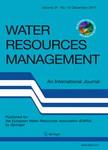版权所有:内蒙古大学图书馆 技术提供:维普资讯• 智图
内蒙古自治区呼和浩特市赛罕区大学西街235号 邮编: 010021

作者机构:Univ Stuttgart Inst Hydraul Engn Stuttgart Germany Univ Munich Inst Comp Sci Programming & Software Engn Munich Germany Ecol Inst Int & European Environm Policy Berlin Germany Natl Water Management Fed Minist Agr Forestry Environm & Water Management Div 7 1 Vienna Austria
出 版 物:《WATER RESOURCES MANAGEMENT》 (水资源管理)
年 卷 期:2010年第24卷第2期
页 面:239-275页
核心收录:
学科分类:08[工学] 0815[工学-水利工程] 0814[工学-土木工程]
基 金:BMBF German Federal Ministry of Education and Research
主 题:Multi-actor approach WaterSupply model Global change DANUBIA Danube Integrated water resources management
摘 要:Glowa-Danube (http://***) is an interdisciplinary project that aims to develop integrated strategies and tools for water and land use management in the upper Danube catchment (Germany, Austria similar to 77,000 km(2)). The project is one of five within the Glowa research program (http://***) dealing with Global Change effects on the water cycle in six meso-scale catchments (up to 100,000 km(2)) in Central Europe, West Africa and the Middle East. In the Glowa-Danube project, 16 natural science and socio-economic simulation models are integrated in the coupled simulation system Danubia. This article describes the underlying concept and implementation of WaterSupply, a multiactor-based model of the water supply sector with a focus on water resource utilization and distribution of individual water supply companies. Within Danubia, WaterSupply represents the link between water supply and demand, where the former is simulated by a groundwater and a surface water model and the latter by water consumption models of four different sectors (domestic, industrial, agricultural and tourism). WaterSupply interprets the quantitative state of water resources for defined spatial and temporal units according to sustainability requirements and assesses the state of resources in relation to present water supply schemes and the dynamics of user demand. WaterSupply then seeks both to optimize the resource use of supply companies and to identify critical regions for which further adaptation of the water supply scheme will become necessary under changing climatic conditions. In this article, a brief description of the Glowa-Danube project and the integrated simulation system Danubia is followed by a short presentation of the DeepActor framework, which provides a common conceptual and technical basis for the socio-economic simulation models of Glowa-Danube. The main body of the article is devoted to the concept, the implementation and simulation results of WaterSup